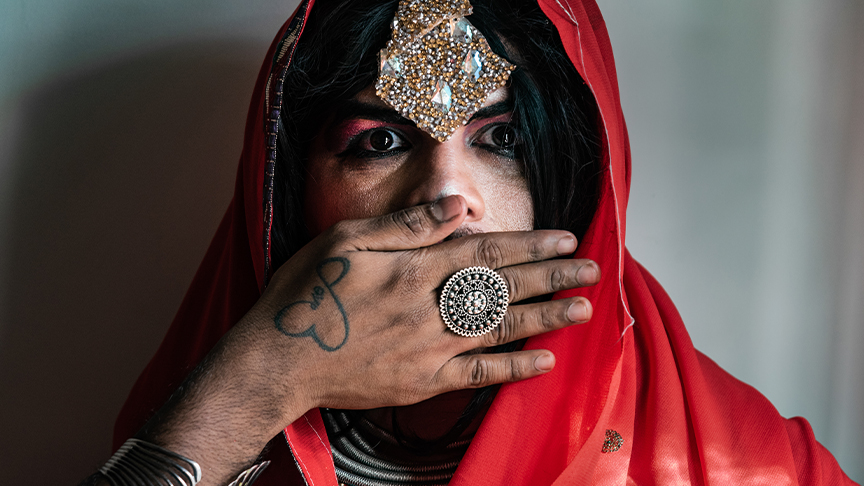Patruni Chidananda Sastry started doing drag at the age of 12, “though I didn’t know it was drag,” they said. At that time, “I was learning and pursuing Indian classical dance, ‘Kuchipudi’, where the young boys dress up as girls and perform on mythological contexts. It was through this that… I dressed as a girl to present a dance piece.”
It took Patruni more time to “conventionally call it drag”, when – starting 2019 – they started to “imbibe the idea of drag in Hyderabad.”
Patruni also recalled that at that time, Hyderabad didn’t have any drag culture.
“Conventional drag has been (reported on) pretty late in India, around 2018-2019,” they said.
This was also the time when Section 377 of the Indian Penal Code (the archaic British “anti-buggery law” that prohibited sexual contact between two men even if they consent) was decriminalized.
“Before that, drag was there as a part of multiple art forms, but not many people used the word ‘drag’. It was not a separate entity of art,” Patruni said.
As such, Hyderabad had never seen someone perform drag and “in an interim discussion with a couple of friends, the idea of hosting a drag show crossed my mind. I was looking for drag queens who can perform for the show and was desperate to get someone… to dress up. Irritated by my constant push, a friend got back to me saying, ‘If you can’t do it yourself, don’t ask others to do it!’.”
That was when Patruni decided to do drag.
“After performing on the first show in June 9, 2019, I found the intersectionality of dance, performance art and theater in drag; and I felt it relevant to pursue it from thereon,” they said.
And so with the passing of time, “my drag has been my way to showcase a visible medium of gender nonconformity and the politics of fashion within the country.”
GOTHIC DRAG
Here’s an interesting thing, though: Patruni actually once referred to what they do as “Gothic drag”.
“My style of drag is inspired by the Tranimal Drag style by Austin Young and Speaky Blonde,” they said, adding that “I was also inspired by Daniel Lismore, who’s style gave me a new way to reflect drag.”
In Tranimal drag, the idea of beauty, glamour and fashion is questioned to the core; the notions of what is aesthetic and what’s not are tossed; and the gender is wiped out of the body to ensure the body is genderless.
“The art of Tranimal becomes available as we use available objects from trash bags to big liners, broken jewelry to face paints… and put it on the body in a non-choreographic way to create an image,” Patruni said.
And so “Gothic drag was one of my explorations where I could bring my Tranimal soul to dwell with the nature of Black and Red, drag and mixed gendered representation of the spooky soul. This style of drag dismissed the idea of beauty, privilege and glamour of the conventional drag, and points out that drag is away from the idea of perfectness. (It is) anti-beauty and privilege less.”
FAMILY… FOR ART
It was actually Patruni’s mom who “helped me dress up as a woman at my first drag show when I was 12 years of age,” they smiled. “And even when I started doing drag as an adult, they were interested in knowing the purpose of art than my choice of choosing the art. They have been extremely supportive and have never stopped me from my gender expressions. At times they are curious to know the why, what and how about the art form and encourage me to push my boundaries time and again.”
FROM INDIA… TO THE WORLD
Patruni – who identifies as a gender fluid pansexual person – recognizes that much of the world that’s exposed to Western culture will be familiar with drag via the likes of RuPaul and Hollywood iterations.
But they said that “drag as any other art form is supposed to be diverse.”
This may be particularly true when “looking through the compass of Indian drag history, where drag has always been diverse and evolving.”
“Sometimes I feel that drag was something which was picked up from India, where men were dress up as women and women dress up as men in more than 50 art forms for centuries,” they said.
The first citation of Roopanurupam (which is drag in Sanskrit) was in Natya Shastra around 200 BC; and because of the colonization, the art transcended to Victorian Era, which then followed to other parts of the world.
“Hence for me, the Indian context has a lot more space worth researching,” they said.
Patruni added: “In Indian drag, there is glamour as well as performance. But when I see the representation in Western drag as shown in RuPaul, I find glamorization as something which is ‘given’, as ‘important’. There is no harm to be beautiful, and there is no right and wrong since art is personal, but drag is way more than that. And when only one aspect of it is highlighted across the world and other versions are not equally given opportunity, that brings up the idea that ‘This is the only right way to do’, which is wrong.”
For Patruni, “I believe all the drag is valid and matter, and we all have to be represented and respected (to) share a holistic vision of drag.”
IS DRAG ANTI-WOMEN?
Drag has also been criticized for being anti-women. For instance, the very definition of drag often excludes women dressing up as men; and drag may be (mis)construed as “playing woman”.
But Patruni said that “drag is both gendered and genderless.”
In India, for instance, there is a very rich culture of having drag in all gender forms – e.g. in Manipuri dance, a woman performs a man’s roles; while in Jatra drag, a man performs in roles of women. There are also forms like Buta Kola and Theeyam where the performing body is neither man nor a woman.
However, perhaps because of the limitations of drag as often portrayed in the West, the “anti-women perspective” is bound to surface.
“Though women perform as bio-queen or drag kings, their entry into the mainstream culture is not so visible,” Patruni said. “It’s equally important to have multiple bodies come and explore the art, and restricting it for only one body/gender type is equivalent to killing the art. Drag can be performed by anyone irrespective of their gender sexuality, caste, race or privileges; and it’s high time we include all performing bodies into the mainstream drag.”
RAISING A CAUSE
Drag artists/performers have also been criticized for “hijacking” many of women’s issues – for example, male drag artists/performers become the “spokespeople” of women’s issues.
In Patruni’s case, for instance, one of their endeavors was to deal with witch-hunting as an issue still affecting many Indian women. It is easy to argue that women, not drag artists/performers, should be speaking about their own issues.
But Patruni said that “as an artist, it is important to question oneself about how we are doing it, why we are doing it, and for whom we are doing it. And one should also keep in mind the spaces artists are standing at while raising a cause. It is important to understand what these spaces are where we can articulate a certain thing, and what are some spaces which we should.”
Patruni recognizes that “when it comes to women’s issues, we need to understand that the (most) drag performers are not biological or transgender women, and hence cannot claim the spaces of women. Their issues are real (and it should) come from them, and not be snatched (by those doing) drag.”
However, adding to the conversation can be done by drag queens.
“As drag is a visual medium, they can add more value to a cause. As a society, all the genders need to have awareness and co-work to make the changes,” Patruni said, stressing – all the same – that “we need to step aside to give space to women to talk about women’s issues.”
And while women voice their issues, “let the men clean up their patriarchal mess. And that’s where drag can help.”
UNDER THE LENS
To highlight Gothic drag, Patruni worked with ace photographer Manab Das for a “photo performance”.
In India, “Goth” hit the headlines for all the wrong reasons – e.g. in connection with a Bollywood actor passing away while staying in a Gothic hotel (“Palazzo Magnani Feroni”) Italy.
“The Goth culture has always been tabooed… in Indian context,” Patruni said.
Patruni likened this Goth shaming with witch shaming, particularly as used in India to refer to self-aware women.
With the merging, therefore, came this output that highlighted everything Patruni is about – e.g. the interdependencies of the illusioned gender and the spooky esthetics of Goth.
ACCEPTANCE THROUGH DRAG
That drag continues to be misunderstood goes without saying. And so if there’s a lesson about drag that Patruni thinks people should know of, it’s “the lesson of acceptance… as it builds, survived and made the art of drag visible. And all individuals – may that be performers, audience, curators, event organizers, TV promoters, et – need to practice that art of acceptance to make it more popular, diverse and heartful.”
For those who continue to look down on drag, “maybe you should consider taking drag therapy,” they said. “Dress up someday and you will fall in love with your self.”
For Patruni, drag is equivalent to sports, drama, dance, music and more. “It’s a package of all in one, and drag performers are happiest people in the world. So if you don’t like our art, I believe you should have a better reason; and to get one, you should dress up one day.”
And so for those who want to do drag, Patruni said for them to just do it.
“Drag is very easy. All you need to do is to do it. The rest comes as you go along. Anyone can be a drag performer and no one can keep you away from being one,” Patruni ended.

































































































